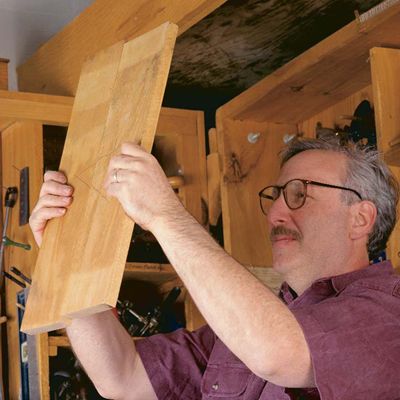Jointing by Hand
Planes make tight edge-joints, quietly and efficiently
Synopsis: Richard Starr, who teaches woodworking to middle-school students, painstakingly joints boards by hand. Edge-glued joints can be inconspicuous and stronger than wood itself, but only if the mating edges have been jointed straight and true, he writes. He suggests planing boards in pairs and using a jack plane and a jointer plane. He explains how he checks his progress; one tip is to hold the boards together up to the light to check for gaps.
Joining boards edge to edge is a skill every woodworker needs. Maybe you can’t find a board wide enough for a panel you’re making, or you need gluedup stock because it will be more stable than a single board. You might want bookmatched pieces or different species of wood side by side. Edge-glued joints can be inconspicuous and stronger than wood itself, but only if the mating edges have been jointed straight and true.
Power jointers certainly have their place in the shop for truing edges. But if your machine is out of whack or if you have to joint unwieldy boards, you can’t beat handplanes. They’re quick, quiet and satisfying. I joint with two planes: a 14-in.-long jack for rough work and a 24-in.-long jointer for final correcting and smoothing.
Plane boards in pairs, if you can
I lay the boards side by side on my bench and shift them until I get a pleasing grain arrangement. A triangular witness mark drawn across each joint indicates mating edges and keeps matching grain aligned. I fold a pair of the boards so the adjoining edges are side by side. If the boards are not too long or too thick, 11⁄4 in. or less, I clamp the pair in my vise with the edges even.
By jointing two boards at once, I don’t have to be concerned if the edges are not exactly 90° to the faces. I joint boards in pairs for all the edge-joints I’m preparing for glueup. I plane thicker boards one at a time.
Use a jack and then a jointer
If the board edges are noticeably rough or wavy, I chop down the high areas using a jack plane set for a coarse cut. Using the jack saves time and wear on my carefully tuned jointer plane. When the edges look pretty flat, I take the boards out of the vise and unfold them, stacking them edge to edge on the bench.
A small space between the boards at the center is a welcome sight, but large gaps at the ends mean I need to shave down the center some more. It helps to hold the joint up to a light to see where the gaps are. When the boards touch at the ends and leave a tiny crack at the middle, I’m ready for the jointer plane.
From Fine Woodworking #119
For the full article, download the PDF below:
Fine Woodworking Recommended Products

Tite-Mark Marking Gauge

Suizan Japanese Pull Saw

Olfa Knife






















Log in or create an account to post a comment.
Sign up Log in